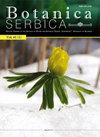塞尔维亚两种本土共生菌株平菇和绿环菌降解木质素化合物的功能分化
IF 1.1
4区 生物学
Q4 PLANT SCIENCES
引用次数: 0
摘要
在自然界中,木质基质通常由整个微生物群落降解,这些微生物群落现在受到人为影响的危害,因此确定每个物种的功能特异性非常重要。研究了来自塞尔维亚低地森林的两株本土真菌(Pleurotus ostreatus Ser1和Cyclocybe aegerita Ser1)降解木质素底物[橡木锯末、橡木分离细胞壁和合成脱氢聚合物(DHP)]的能力。测量木质素降解酶的活性,同时检测真菌生长介质中酚类物质的HPLC图谱,以及木质素的损失。平菇Ser1在很短的时间内表现出很高的降解效率,而绿环菌Ser1则不能降解木质素。这种情况是由于平菇Ser1培养基中酶活性非常高,酚类物质含量很低,而绿环菇Ser1培养基中酶活性非常低,酚类物质含量很高。本文章由计算机程序翻译,如有差异,请以英文原文为准。
Functional differentiation of two autochthonous cohabiting strains of Pleurotus ostreatus and Cyclocybe aegerita from Serbia in lignin compound degradation
In nature, woody substrates are usually degraded by entire communities of microorganisms, which are nowadays jeopardised by anthropogenic influence, making it important to define the functional specificity of every species. Two strains of autochthonous fungi from Serbian lowland forests (Pleurotus ostreatus Ser1 and Cyclocybe aegerita Ser1) have been investigated for their ability to degrade lignin substrates [oak sawdust, oak isolated cell walls, and synthetic dehydrogenative polymer (DHP)]. Measuring the activities of the enzymes involved in lignin degradation was coupled with detecting the HPLC profile of the phenolics in the fungal growth media, and the lignin loss. While Pleurotus ostreatus Ser1 appeared highly effective within a very short time span, Cyclocybe aegerita Ser1 failed to degrade lignin. This situation was supported by very high enzyme activities and the low presence of phenolics in the media of Pleurotus ostreatus Ser1, compared to very low enzyme activity and the high presence of phenolics in the media with Cyclocybe aegerita Ser1.
求助全文
通过发布文献求助,成功后即可免费获取论文全文。
去求助
来源期刊

Botanica Serbica
Agricultural and Biological Sciences-Plant Science
CiteScore
1.40
自引率
12.50%
发文量
17
审稿时长
34 weeks
期刊介绍:
Botanica Serbica publishes original research papers on all aspects of plant, fungal and microbial biology research including the disciplines of microbiology, mycology, lichenology, bryology, flora, vegetation, biogeography, systematics, taxonomy, plant biotechnology, plant cell biology, plant ecology, environmental plant biology, forestry, genomics, horticulture, limnology, metabolomics, molecular biology, proteomics, virology, plant conservation and protection, and wildlife and ecosystem management.
 求助内容:
求助内容: 应助结果提醒方式:
应助结果提醒方式:


